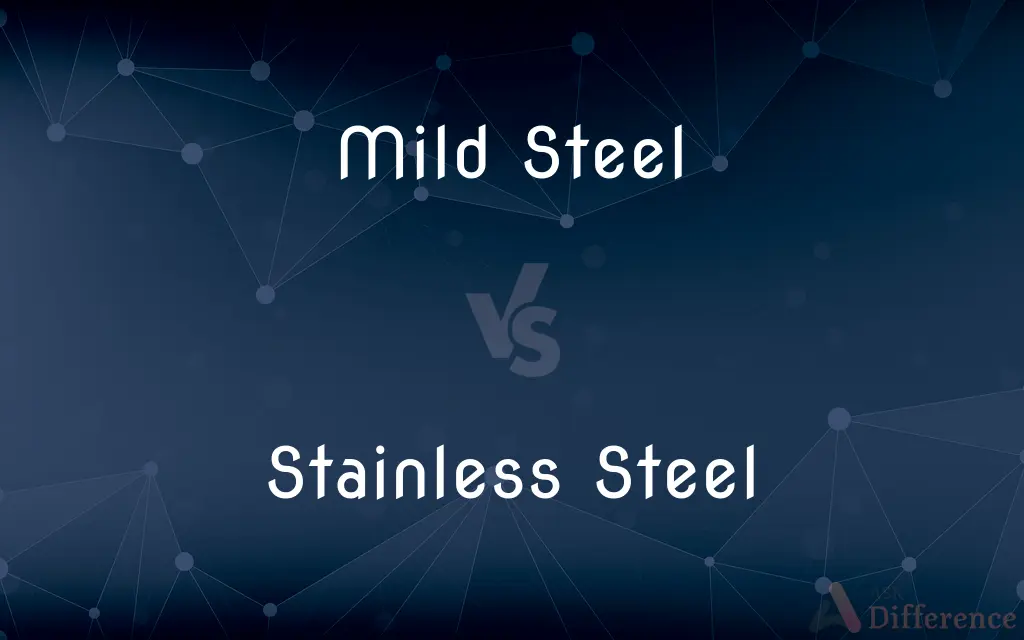Mild Steel vs. Stainless Steel — What's the Difference?
Edited by Tayyaba Rehman — By Fiza Rafique — Published on January 14, 2024
Mild Steel is an iron alloy with minimal carbon content, making it more malleable but prone to rust. Stainless Steel contains chromium, offering higher resistance to corrosion and staining.

Difference Between Mild Steel and Stainless Steel
Table of Contents
ADVERTISEMENT
Key Differences
Mild Steel and Stainless Steel are both alloys, primarily made of iron, but they differ significantly in composition and properties. While Mild Steel contains a low amount of carbon, generally less than 0.3%, Stainless Steel contains a minimum of 10.5% chromium that provides its anti-corrosive properties.
The low carbon content in Mild Steel makes it highly malleable, making it suitable for forging and welding. On the other hand, Stainless Steel, because of its chromium content, forms a thin layer of oxide on its surface, which prevents it from rusting or corroding easily.
One key distinction between Mild Steel and Stainless Steel is their appearance over time. Mild Steel, without proper care, can rust and corrode rapidly when exposed to moisture, while Stainless Steel maintains its shine and luster due to its resistance to staining and corrosion.
From a cost perspective, Mild Steel is generally more affordable than Stainless Steel. This is because the process to create Stainless Steel, which includes adding chromium and often nickel, is more complex and resource-intensive than producing Mild Steel.
In terms of applications, Mild Steel is commonly used in construction and car manufacturing due to its strength and malleability. Stainless Steel, with its corrosion resistance, is preferred in kitchen utensils, medical instruments, and other scenarios where durability against rust is essential.
ADVERTISEMENT
Comparison Chart
Carbon Content
Less than 0.3%
Varies, but typically low
Corrosion Resistance
Low (prone to rust)
High (due to chromium content)
Malleability
High
Varies depending on type
Cost
Generally less expensive
More expensive due to chromium content
Typical Applications
Construction, car manufacturing
Kitchenware, medical instruments, jewelry
Compare with Definitions
Mild Steel
An iron alloy with a low carbon content.
The bridge was constructed using Mild Steel beams.
Stainless Steel
Alloyed steel that maintains its appearance over time.
The Stainless Steel watch still looked brand new after years of use.
Mild Steel
Steel that is susceptible to rust when exposed to moisture.
The Mild Steel fence began to rust after the rainy season.
Stainless Steel
A durable steel often used in medical instruments.
Surgeons prefer Stainless Steel tools for their cleanliness and durability.
Mild Steel
A common steel used in construction due to its strength.
They chose Mild Steel for the building's foundation.
Stainless Steel
An alloy steel containing a minimum of 10.5% chromium.
Stainless Steel utensils are popular due to their rust resistance.
Mild Steel
A type of carbon steel known for its malleability.
Blacksmiths often prefer Mild Steel for forging.
Stainless Steel
Steel known for its resistance to corrosion and staining.
The new kitchen had Stainless Steel appliances.
Mild Steel
Steel with a simple iron and carbon composition.
Mild Steel is often chosen for its affordability.
Stainless Steel
Iron alloy with added elements for enhanced durability.
For outdoor installations, they chose Stainless Steel fixtures.
Stainless Steel
Alternative spelling of stainless steel
Common Curiosities
Does Stainless Steel never rust?
Not necessarily. While more resistant, certain conditions or chemicals can still cause it to rust.
What primarily differentiates Mild Steel from Stainless Steel?
The primary difference is the chromium content; Stainless Steel has it, providing corrosion resistance, while Mild Steel doesn't.
Why is Stainless Steel more expensive?
The addition of chromium and often nickel makes its production costlier.
Why is Stainless Steel often used in medical equipment?
Its resistance to corrosion makes it hygienic and durable for medical use.
Are there different grades of Stainless Steel?
Yes, there are multiple grades, each with varying properties and applications.
Is Mild Steel suitable for kitchenware?
No, it can rust. Stainless Steel is preferred for kitchenware due to its rust resistance.
Which type of steel is better for welding?
Mild Steel is generally easier to weld than many types of Stainless Steel.
How can I differentiate between Mild Steel and Stainless Steel in practice?
A simple test is the magnet test; Stainless Steel (specifically, the 300 series) is generally non-magnetic.
Can Stainless Steel be hardened like Mild Steel?
Some grades of Stainless Steel can be hardened, but methods differ from Mild Steel.
Which is more malleable: Mild Steel or Stainless Steel?
Mild Steel is generally more malleable.
Can Mild Steel be treated to resist rust?
Yes, through processes like galvanization.
Are Stainless Steel products always made of 100% Stainless Steel?
No, sometimes only the outer layer is Stainless Steel for appearance and corrosion resistance.
Why do Stainless Steel appliances remain popular in homes?
They offer a modern look, and their resistance to staining and rusting makes them durable.
Is Mild Steel magnetic?
Yes, Mild Steel is generally magnetic.
Which is heavier: Mild Steel or Stainless Steel?
Their weight can be similar, but it varies based on the specific alloy and application.
Share Your Discovery

Previous Comparison
Centripetal Acceleration vs. Centrifugal Acceleration
Next Comparison
Moist Heat Sterilization vs. Dry Heat SterilizationAuthor Spotlight
Written by
Fiza RafiqueFiza Rafique is a skilled content writer at AskDifference.com, where she meticulously refines and enhances written pieces. Drawing from her vast editorial expertise, Fiza ensures clarity, accuracy, and precision in every article. Passionate about language, she continually seeks to elevate the quality of content for readers worldwide.
Edited by
Tayyaba RehmanTayyaba Rehman is a distinguished writer, currently serving as a primary contributor to askdifference.com. As a researcher in semantics and etymology, Tayyaba's passion for the complexity of languages and their distinctions has found a perfect home on the platform. Tayyaba delves into the intricacies of language, distinguishing between commonly confused words and phrases, thereby providing clarity for readers worldwide.
















































